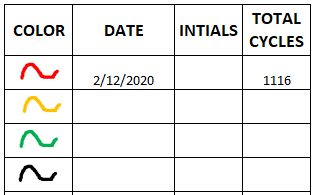Phase I Visual Distress Survey
Daily distress surveys were conducted in accordance with ASTM D5340. Distresses were outlined with chalk and measured using a tape measure. The surveys recorded the changes to existing distresses and any new distresses. Visual distress surveys were documented in two ways: a scale map and a written log. The distress map shows all distresses to scale and keys each distress to a pass number/cycle number and joint ID.The figure below shows sample distress maps for both joints TT34 and TO34. At each joint, distresses were recorded on the top, west, and east vertical edges. Distresses are numbered for reference to the written log. The written log records all the distress information chronologically. The written log records the date, pass number, type of distress, distress number (which can be cross-referenced to the distress map), the location of the distress, and any relevant notes. The notes may indicate changes to existing distresses, severity levels, merging of multiple previously identified distresses, etc.
The complete Distress Map and Log can be found here.


(a) TT34 Joint of TT Section (Click Image to Zoom)

(b) TO34 Joint of TO Section (Click Image to Zoom)
Sample Distress Map (Portion)

Sample Log (Portion) (Click Image to Zoom)
As shown in below, reflection cracks were first observed on the 2nd day of traffic testing (i.e., February 12, 2020) after cumulative pass #1162. These cracks were located on both the east and west sides along joint TT34, TT45, and TT56. After initiation, the progress of bottom-up cracks varied. For instance, on the west side of joint TT45, the crack reached 1.4 inch mark from the overlay bottom, as reported on February 14, 2020, after cumulative pass #2356.
Traffic History and Distress Observation on TT Section
|
Day
|
Date
|
Cumulative Passes
|
Distress Observation
|
|
1
|
2/11/2020
|
496
|
No crack initiated
|
|
2
|
2/12/2020
|
1162
|
(a) TT34 joint west side: 3 mm (approximate) vertical hairline crack, in asphalt at concrete joint, then the hairline crack moved to the right for 40 mm (approximate) parallel to the concrete surface
(b) TT45 joint west side: 10 mm (approximate) vertical hairline crack, in asphalt at concrete joint at approximately 45 degrees to the left, then the hairline crack moved to the right for 40 mm (approximate) parallel to the concrete surface
(c) TT45 joint east side 4 mm (approximate) vertical hairline crack, in asphalt at concrete joint at approximately 45 degrees to the left, then the hairline crack moved to the right for 40 mm (approximate) parallel to the concrete surface
(d) TT56 joint west side: 2 hairline vertical cracks 4 mm each at the joint then moved 50 mm individually one to the right the other to the left of joint parallel to the concrete surface
(e) TT56 joint east side: 4 mm (approximate) vertical hairline crack, in asphalt at concrete joint, then the hairline crack moved to the right for 30 mm (approximate) parallel to the concrete surface
|
|
3
|
2/13/2020
|
1736
|
No further propagation observed on the existing crack
|
|
4
|
2/14/2020
|
2356
|
(a) TT45 joint west side: Bottom up crack reaches the height of 1.4 inch
(b) No further propagation observed on other joints
|
|
5
|
2/18/2020
|
2976
|
No further propagation observed on the existing crack
|
Return to RCOD Main Page